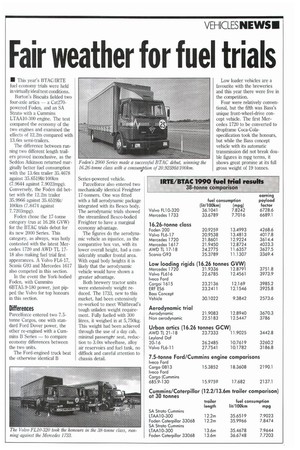Fair weather for fuel trials
Page 15

If you've noticed an error in this article please click here to report it so we can fix it.
• This year's BTAC/IRTE fuel economy trials were held in virtually ideal test conditions.
Burton's Biscuits fielded two four-axle artics a Cat270powered Foden, and an SA Strato with a Cummins LTAA10-300 engine. The test compared the economy of the two engines and examined the effects of 12.2m compared with 13.6m semi-trailers.
The difference between running two different length trailers proved inconclusive, as the Seddon Atkinson returned marginally better fuel consumption with the 13.6m trailer 35.4678 against 35.6519lit/100km (7.9644 against 7.9023mpg). Conversely, the Foden did better with the 12.2m trailer 35.9966 against 35.65191it/ 100km (7.8474 against 7.7203mpg).
Foden chose the 17-tonne category (run at 16.26t GVW) for the BTAC trials debut for its new 2000 Series. This category, as always, was hotly contested with the latest Mercedes 1720 and AWD IL 1718 also making fuel trial first appearances. A Volvo FL6-17, Scania G93 and Mercedes 1617 also competed in this section.
In the event the York-bodied Foden, with Cummins 6BTA5.9-180 power, just pipped the Volvo for top honours in this section.
Differences Parcelforce entered two 7.5tonne Cargos, one with standard Ford Dover power, the other re-engjned with a Cummins B Series to compare economy differences between the two units.
The Ford-engined truck beat the otherwise identical B Series-powered vehicle.
Parcelforce also entered two mechanically identical Freighter 17-tonners. One was fitted with a full aerodynamic package integrated with its Besco body. The aerodynamic trials showed the streamlined Besco-bodied Freighter to have a marginal economy advantage.
The figures do the aerodynamic vehicle an injustice, as the comparative box van, with its lower overall height, had a considerably smaller frontal area. With equal body heights it is likely that the aerodynamic vehicle would have shown a greater advantage.
Both brewery tractor units were extensively weight reduced. The 1733, new to this market, had been extensively re-worked to meet Whitbread's tough unladen weight requirement. Fully fuelled with 300 litres, it weighed in at 5,750kg. This weight had been achieved through the use of a day cab, minimal passeng6r seat, reduction to 3.0m wheelbase, alloy air reservoirs and fuel tank, no difflock and careful attention to chassis detail. Low loader vehicles are a favourite with the breweries and this year there were five in the competition.
Four were relatively conventional, but the fifth was Bass's unique front-wheel-drive concept vehicle. The first Mercedes 1720 to be converted to dropframe Coca-Colaspecification took the honours, but while the Bass concept vehicle with its automatic transmission did not break double figures in mpg terms, it shows great promise at its full gross weight of 19 tonnes.






















































































































































































